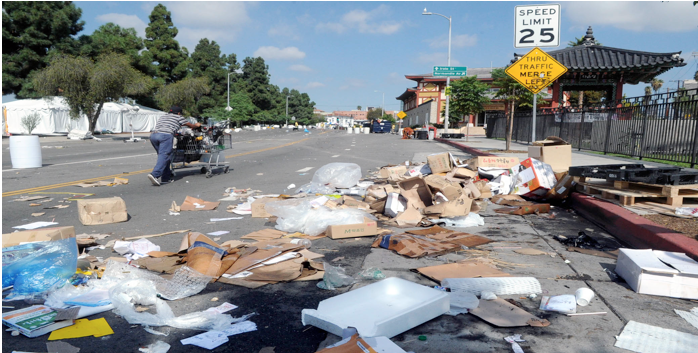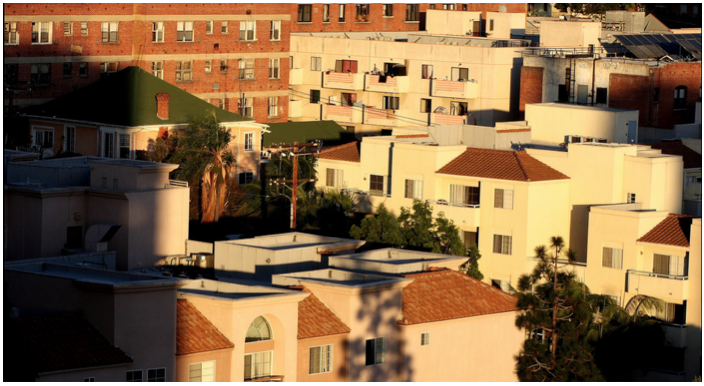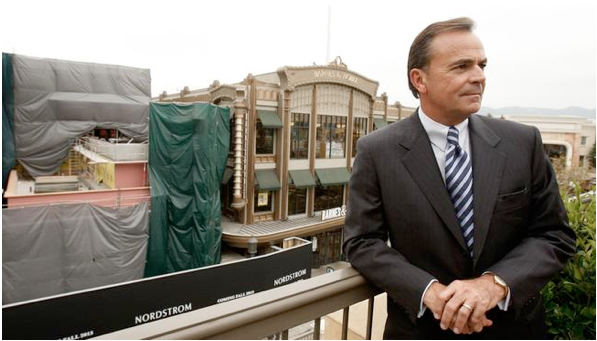Scientific Theory of LA’s Decline
CORRUPTION WATCH-According to the “Osmosis Theory of LA’s Decline,” populations tend to move from areas of high costs and low opportunity (HC-LO) to areas of low costs and high opportunity (LC-HO.) Darwin’s survival of the fittest has a say here too. The smarter the person, the more likely he or she will move away from Los Angeles. In other words, the more talented middle class is “osmosisizing” itself away from “high cost-low opportunity” Los Angeles to “low cost-high opportunity” areas like Texas, the South, Nashville and Arizona. (Photo above: uncollected trash in Koreatown, Los Angles.)
There are other factors in LA’s plight. Because babies cannot move out on their own, newborns are not renting apartments and buying houses. The elderly often own their own homes and have their costs covered. Thus, the new births and the “not-dying” of the Boomers do not mean LA is seeing an increased demand for housing.
The crucial element of population mathematics is that Los Angeles is driving out the most vital segment of its population, that is, the family age middle class. As they leave the City, we lose our future. (We have previously discussed in CityWatch on December 29, 2016, why LA has a lower demand for housing while housing prices rise.)
Two Productive Segments of LA’s Middle Class
Los Angeles’ middle class of child rearing age spans two “generations.” There are Family Millennials, born between 1981 and 1998. Their peak birth year was twenty-five years ago. Thus, there are fewer younger Millennials each year and an increasing number of the older Millennials are becoming Family Millennials, age 25 and above.
Los Angeles’ other middle class “generation” is its Generation Xers, who are between the ages of 35 to 49 years old. Los Angeles already is deficient in its number of Gen Xers. While Garcetti and others were raving about the young Millennials living on groups of two and three in lofts in DTLA, they covered up the fact that the Gen Xers were leaving the City.
Many in this group, who were between 27 and 41 years old when the Crash of 2008 hit, have mostly decided to leave dense urban areas. Although this generation is smaller than the Baby Boomers above them and the Millennials below them, Gen Xers are vital for any urban area for the next two decades. They are wealthier and more entrepreneurial than Family Millennials and their prior departure is one of the reasons Los Angeles has lost more employers than any other urban area over the prior decade.
People with the entrepreneurial spirt are precisely the type that leaves the high cost-low opportunity of Los Angeles for the low cost-high opportunity areas in Texas. In fact, Austin (the capital of Texas,) was the grand winner in attracting Gen X entrepreneurials. Since 2000, Austin’s Gen Xers have increase by 44.9% despite the fact that the size of this population segment has declined 6.6% nationally and Los Angeles is doing even worse than the national average.
As Joel Kotkin and Wendell Cox wrote in NewGeography.com in December 2016, “This makes sense as this is the age when home ownership is most critical and people are looking for the maximum income relative to costs. Being in your late 30s to 50 does not mean you have lost the ability to dream, but it does make addressing reality far more imperative than when in your 20s.”
Thus, a significant number of Gen Xers have left Los Angeles and the age group just below them, Family Millennials, is doing likewise. Both generations leave for basically the same reason -- LA is high cost with low opportunity. People want their children to do better than they are doing. Thus, families move to the low cost-high opportunity areas.
Losing both GenXers and Family Millennials is Financially Devastating to Los Angeles
According to Val Srinivas and Urval Goradia, writing in “The Future of Wealth in the United States Mapping Trends in Generational Wealth,” for the Deloitte University Press in November 2015, “…Generation X will experience the highest increase in share of national wealth through the forecast period, growing from under 14 percent of total net wealth in 2015 to nearly 31 percent by 2030. In contrast, “The Millennial generation will experience the fastest growth rate of net wealth. However, the generation’s share of national household wealth will remain below 20 percent.”
By 2030, the Gen Xers and Family Millennials will control about 50% of the nation’s wealth. Any urban area that loses the middle class from both these generations will lack the financial wherewithal to sustain itself. The middle class has proven it will not raise its families in cramped high rises in Hollywood or DTLA or at Gehry’s Folly at 8160 Sunset. The on-going destruction of Valley Village’s residential areas is particularly ominous for the viability of the entire Valley.
Los Angeles’ Absurd Solution is to Spend Billions on Construction
Politicos have fallen in love with the disastrous notion that Los Angeles should make construction of extremely dense Transit Oriented Districts [TODs] and Infill projects its main business. This idea is a perversion of the Keynesian principle that during a recession, spending money helps a society to recover. If the government cannot find something worthwhile to construct, then, Keynes said, it can pay people to dig holes and fill them up again. The money paid to the workers will be spent in the stores, that will then make it possible to hire more employees and buy more products from suppliers.
This principle is sound, but Keynes never encouraged spending money on harmful projects. (If there were a bona fide housing shortage, residential construction would satisfy Keynes’s requirements, but our Crash of 2008 was caused by spending billions of dollars to build into a glut – which is exactly what Los Angeles is doing.)
As mentioned in a prior article, destroying rent-controlled housing in order to build luxury housing is atrocious macro-economic policy and harms society. Furthermore, the subsidy of unwanted luxury housing harms the Price System by misleading people into thinking that financing more high rises is a wise use of investment capital. Again, this dynamic plus massive fraud resulted in the Crash of 2008.
It seems that both California’s Governor and LA City leaders think that deficit spending on construction should be Los Angeles’ prime business. While the spending of billions of dollars will have a short term stimulus, the long term impact will be devastating.
The Crucial Exodus Time is Nigh
When people expect prices to rise, people buy before the increase. The Family Millennials and Generation Xers are beginning to realize that home prices in Austin, Texas, outside Nashville and Atlanta, etc. are rising. Now is the time for them to jettison LA and buy where costs are still low and opportunity is high. As Gen Xers and Family Millennials see that home prices in other areas of the nation are beginning to increase, their departure rate from LA will accelerate. The few Gen Zers who are still here will soon realize that they need to unload their properties in LA before the next crash as well as buy elsewhere before those housing prices significantly increase.
The temporary inflation in R-1 prices will benefit the Gen Xers who did not move away prior to the Crash of 2008. As they move to higher management levels, they can afford better homes. They realize that selling their R-1 homes in Valley Village is their last chance to get their money out of their Valley homes. The financial pressure to escape from LA is irresistible.
A Gen Xer can sell an LA home for $1 million and buy a larger home in Texas for only $450,000. The housing cost differential between Los Angeles and Texas and Nashville and Atlanta, etc. is go great, that the equity in an LA home may allow a Gen X family to buy a better home for all cash. At the very least, the family will have a whopping down payment with a very small mortgage. For Gen Xers, opportunity is knocking twice.
The Impact of Measure S
The Neighborhood Integrity Initiative is officially on the March 2017 ballot as Measure S. If it passes, it will halt the most dramatic threat to LA’s future, i.e., the mega projects, which are at the root of the extortion and bribery running LA City Hall.
Even if Measure S passes, however, Infill developers will continue to bid up the prices of residences way beyond their value as mere living space. If all single homes were re-zoned R-1, no matter what higher zoning surrounded them, families could afford to look for a home in LA. Such a down zoning would prevent the Infill developers from bidding up home prices and a family could feel secure that its residential neighborhood would be safe from developers for decades. The opposite will continue to be the situation for LA. Residential prices will temporarily escalate as Infill developers bid up the purchase prices.
Science Will Prevail
Despite misinformation from City Hall and its apologists like Christopher Thornberg of Beacon Economics and Joel Singer of California Association of Realtors on Channel 4's Conan Nolan’s show, the osmosis-like movement of talented middle class from Los Angeles to the suburbs in Arizona, Texas and the rest of the Sun Belt will prevail. Has there ever been a time in history when people voluntarily moved away from low cost-high opportunity areas to high cost-low opportunity areas?
(Richard Lee Abrams is a Los Angeles attorney. He can be reached at: [email protected]. Abrams views are his own and do not necessarily reflect the views of CityWatch.) Edited for CityWatch by Linda Abrams.













 Then we received this notice announcing the City of Los Angeles’ gifting of delicious,
Then we received this notice announcing the City of Los Angeles’ gifting of delicious, 









 “If we create a system where we’re providing representation for some categories of people because we consider them ‘deserving,'” Emi MacLean, (photo left) an attorney with the National Day Laborer Organizing Network told me, “we’re just reinforcing this really hateful, fear-mongering rhetoric of the incoming Trump administration.” MacLean’s group is pushing the measure at the city and county level in Los Angeles. In the face of the full frontal attack that immigrants expect will follow Trump’s inauguration, MacLean believes that the proper strategy is to lock arms and allow no one to be thrown under the bus.
“If we create a system where we’re providing representation for some categories of people because we consider them ‘deserving,'” Emi MacLean, (photo left) an attorney with the National Day Laborer Organizing Network told me, “we’re just reinforcing this really hateful, fear-mongering rhetoric of the incoming Trump administration.” MacLean’s group is pushing the measure at the city and county level in Los Angeles. In the face of the full frontal attack that immigrants expect will follow Trump’s inauguration, MacLean believes that the proper strategy is to lock arms and allow no one to be thrown under the bus. 












